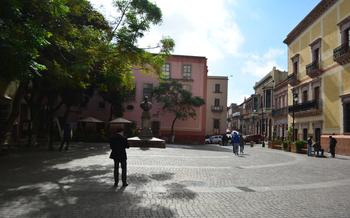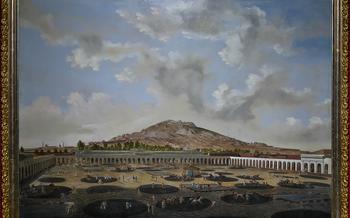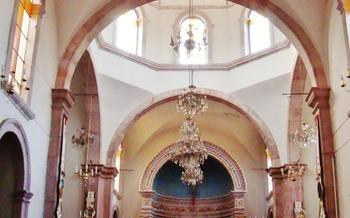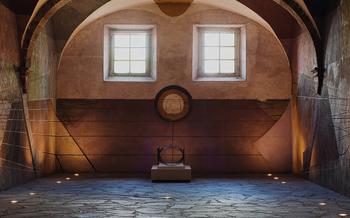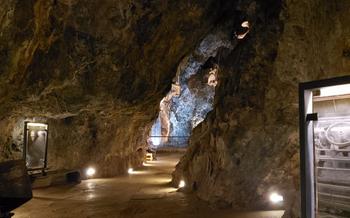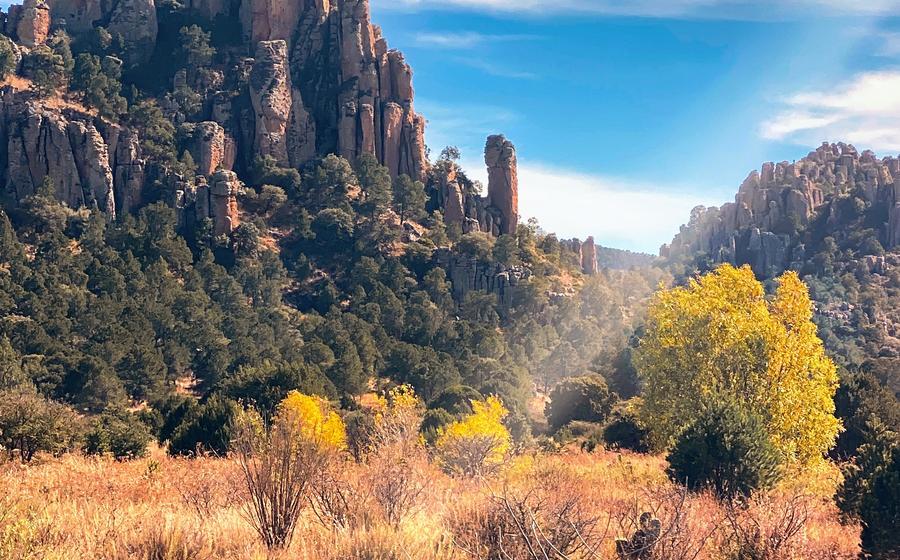
Sierra de Órganos National Park
- Sierra de Órganos National Park: A Geological Wonder
- Exploring the Park: A Journey Through Unique Landscapes
- The Organs: A Majestic Sight
- Cueva de los Chivos: A Hidden Gem
- Pictographs and Petroglyphs: A Glimpse into the Past
- Gastronomic Delights: Savoring Local Flavors
- Stargazing: Under the Vast Desert Sky
- Camping and Lodging: Embracing the Outdoors
- Respecting the Environment: A Responsible Traveler's Guide
- Insider Tip: Unveiling Hidden Gems
Sierra de Órganos National Park: A Geological Wonder
Nestganos National Park is a mesmerizing display of geological wonders. Its distinctive rock formations, known as "organs," rise majestically from the arid landscape, creating an awe-inspiring panorama that resembles a cathedral of stone. These towering pillars, sculpted by millions of years of wind and water erosion, exhibit intricate shapes and textures, each telling a story of the earth's dynamic history.
The park's fascinating geological formations are complemented by a diverse array of flora and fauna. Endemic plant species, adapted to the harsh desert conditions, thrive in the park's unique microclimates. Desert succulents, cacti, and yuccas dot the landscape, adding vibrant colors to the otherwise monochromatic terrain. The park's diverse ecosystem also supports a variety of animal species, including birds, reptiles, and mammals. Keen-eyed visitors may spot roadrunners, hawks, and even the elusive Mexican wolf, a critically endangered species that finds refuge within the park's protected boundaries.
Beyond its geological and ecological significance, Sierra de Órganos National Park holds deep cultural significance for the local communities. Indigenous legends and traditions intertwined with the park's unique landscapes, enriching its natural wonders with a layer of cultural heritage. The park's iconic organs are believed to be the petrified remains of ancient musicians, frozen in time as they played their instruments. These legends, passed down through generations, add a mystical aura to the already enchanting scenery, inviting visitors to explore not just the physical beauty of the park but also its rich cultural tapestry.
Exploring the Park: A Journey Through Unique Landscapes
The Sierra de Órganos National Park offers a network of well-maintained hiking trails that cater to different skill levels and interests. For those seeking a leisurely stroll, the Cueva del Gato Trail provides a gentle introduction to the park's stunning scenery. This 5-mile loop trail leads through a picturesque canyon and culminates in a hidden cave that offers shelter from the sun and an opportunity to spot wildlife.
If you're up for a more challenging hike, embark on the La Ventana Trail, a 3-mile out-and-back trail that rewards hikers with breathtaking views of the valley below. The trail traverses a series of switchbacks and crosses through a lush forest before reaching its namesake viewpoint, a natural rock window that frames the surrounding landscape.
For an unforgettable experience, tackle the Sierra de Órganos Peak Trail, a strenuous 5-mile loop trail that leads to the highest point in the park. The trail offers panoramic vistas of the Organs and the surrounding peaks, making it a popular destination for sunrise and sunset viewing.
Along the way, be sure to pause at the many scenic viewpoints that offer breathtaking vistas of the Organs and the surrounding landscapes. These viewpoints are perfect for capturing panoramic photographs or simply soaking in the beauty of the park.
Guided tours are also available for those who prefer a more informative and immersive experience. Led by knowledgeable park rangers, these tours provide insights into the park's geology, flora, and fauna, as well as its cultural and historical significance.
The Organs: A Majestic Sight
Rock formations:
The Sierra de Órganos National Park is named after its most distinctive feature: the towering rock formations known as "The Organs." These colossal pillars rise from the desert floor, reaching heights of over 60 meters. Their unique shape and arrangement resemble the pipes of a giant organ, giving the park its name. The organs were formed over millions of years through the erosion of volcanic rock by wind, water, and seismic activity. The result is a breathtaking landscape that is unlike anything else in the world.
Geological processes:
The rock formations of the Sierra de Órganos National Park are a testament to the power of geological processes. The park lies within the Trans-Mexican Volcanic Belt, a region known for its volcanic activity. Millions of years ago, magma from the Earth's interior rose to the surface, forming volcanoes. Over time, these volcanoes eroded, leaving behind the distinctive rock formations we see today. The erosion process was aided by the region's arid climate and strong winds.
Photography opportunities:
The Sierra de Órganos National Park is a photographer's paradise. The unique rock formations, combined with the desert landscape, provide endless opportunities for capturing stunning images. The best time to visit the park for photography is early morning or late afternoon, when the light is soft and golden.
Cueva de los Chivos: A Hidden Gem
Venturing into the Cueva de los Chivos, a hidden gem nestled within the Sierra de Ó must-visit for those seeking a unique and immersive experience.
The Cueva de los Chivos, Spanish for "Cave of the Goats," derives its name from the presence of goat bones discovered within its chambers, hinting at the presence of these animals in the past. As you embark on a guided tour, you'll be captivated by the cave's intricate formations, including stalactites and stalagmites that have been shaped over millennia by the relentless drip of water.
The cave's significance extends beyond its geological wonders. Archaeological excavations have revealed evidence of human habitation dating back to pre-Hispanic times. Ancient pictographs and petroglyphs adorn the cave walls, offering a glimpse into the lives and beliefs of the region's early inhabitants. These enigmatic symbols and drawings provide a tangible link to the past, inviting visitors to ponder the stories they hold.
Exploring the Cueva de los Chivos is an experience that combines adventure, history, and cultural immersion. As you navigate the cave's chambers, you'll gain a deeper appreciation for the region's rich heritage and the enduring connection between humans and the natural world. Embrace the opportunity to delve into this subterranean wonderland and uncover the secrets that lie within.
Pictographs and Petroglyphs: A Glimpse into the Past
The Sierra de Órganos National Park is home to a remarkable collection of pictographs and petroglyphs, offering visitors a glimpse into the rich cultural history of the region. These ancient artworks, created by indigenous peoples over centuries, adorn rock surfaces throughout the park, telling stories of their lives, beliefs, and traditions.
Types and Locations: - Pictographs: These colorful paintings, created using natural pigments, depict various subjects, including human figures, animals, and abstract symbols. They are found in sheltered areas, such as caves and rock overhangs, where they have been preserved from weathering. - Petroglyphs: Carved into the rock surface using sharp tools, petroglyphs are more durable than pictographs and often depict geometric patterns, hunting scenes, and mythological figures. They are found on exposed rock surfaces, particularly on large boulders and cliff faces.
Cultural Importance: - The pictographs and petroglyphs of Sierra de Órganos National Park provide valuable insights into the lives and beliefs of the indigenous cultures that inhabited the region. They depict scenes of everyday life, hunting expeditions, rituals, and spiritual ceremonies, offering a glimpse into their worldview and cultural practices. - The artworks also serve as a reminder of the deep connection between the indigenous peoples and their natural surroundings. Many of the depicted elements, such as animals and plants, hold cultural significance and were often associated with deities or spiritual beliefs.
Interpretation: - To fully appreciate the meaning and significance of these ancient artworks, it is essential to understand their context and symbolism. Guided tours led by knowledgeable local guides are available, providing visitors with insights into the stories and symbols depicted in the pictographs and petroglyphs. - Visitors are encouraged to respect and preserve these fragile relics of the past. Touching or tracing the artworks can damage the delicate surfaces, eroding their details and diminishing their cultural significance.
Gastronomic Delights: Savoring Local Flavors
Embark on a culinary adventure in Mexico, Zacatecas, and savor the unique flavors of the region. Traditional dishes, such as enchiladas zacatecanas, pozole, and birria de chivo, tantalize taste buds with their rich and spicy notes. Local specialties, like queso fresco de Jerez and tacos de barbacoa, offer a taste of the region's culinary heritage.
To indulge in an authentic dining experience, venture into the heart of the city and visit the Mercado González Ortega, a vibrant marketplace teeming with food stalls and local eateries. Here, you can sample freshly made tortillas, tamales, and antojitos mexicanos.
For a fine-dining experience, book a table at one of the many hacienda-style restaurants, where you can savor regional delicacies accompanied by live music and panoramic views of the surrounding landscapes.
Whether you prefer street food or fine dining, Mexico, Zacatecas, promises a culinary journey that will awaken your taste buds and leave you with lasting memories.
Stargazing: Under the Vast Desert Sky
The Sierra de Órganos National Park offers unparalleled opportunities for stargazing thanks to its remote location and minimal light pollution. On a clear night, the sky comes alive with a myriad of stars, planets, and constellations, visible with the naked eye. Visitors can easily spot the Milky Way stretching across the heavens, showcasing its intricate details and celestial wonders.
For those seeking a more immersive experience, guided stargazing tours are available. These tours typically include expert astronomers who provide insights into the night sky, identify constellations, and explain celestial phenomena. Participants can learn about the history, mythology, and science behind the stars, planets, and galaxies, enriching their understanding of the universe.
Astrophotography enthusiasts will find the Sierra de Órganos National Park a haven for capturing stunning images of the night sky. The absence of city lights allows for clear and crisp astrophotography, resulting in breathtaking shots of the cosmos. With a steady tripod and a wide-angle lens, visitors can capture the beauty of the Milky Way, star clusters, nebulae, and distant galaxies.
Camping and Lodging: Embracing the Outdoors
For those seeking a more immersive experience, camping within the Sierra de Órganos National Park offers a unique opportunity to connect with nature. Designated campsites are available, providing basic amenities like restrooms and picnic tables. These campsites are ideal for pitching a tent or parking an RV, allowing visitors to wake up to the stunning views of the park's geological formations.
For those preferring a more comfortable stay, various hotels and accommodations are located in the nearby towns of Sombrerete and Chalchihuites. These charming towns offer a range of options, from cozy bed and breakfasts to modern hotels, catering to different budgets and preferences. Staying in these towns provides easy access to the park while allowing visitors to explore the rich cultural heritage of the region.
Respecting the Environment: A Responsible Traveler's Guide
As travelers, we have a responsibility to tread lightly and leave no trace in the natural wonders we visit. The Sierra de Órganos National Park is a delicate ecosystem that requires our utmost care and consideration.
To minimize our environmental impact, we should adhere to the leave no trace principles. This means packing out all trash, including food scraps and wrappers. We should also avoid disturbing plants and animals, and stay on designated trails to prevent erosion.
When encountering wildlife, we should maintain a respectful distance and avoid any actions that may startle or disturb them. Photography is a great way to capture the beauty of the park's inhabitants without disrupting their natural behavior.
By following these guidelines, we can help preserve the pristine beauty of the Sierra de Órganos National Park for generations to come.
Insider Tip: Unveiling Hidden Gems
Beyond the main attractions, the Sierra de Órganos National Park holds hidden gems waiting to be discovered by adventurous souls. Venture off the beaten path to find secluded viewpoints that offer unparalleled panoramas of the park's rugged landscapes. Follow lesser-known trails that lead to hidden caves adorned with ancient pictographs and petroglyphs, telling tales of forgotten civilizations. Discover natural swimming holes tucked away amidst the rocks, inviting you to take a refreshing dip in the crystal-clear waters. Embrace the spirit of exploration and uncover the secrets that the park keeps hidden for those who dare to seek them.
